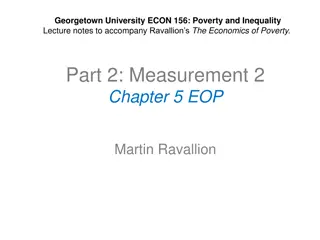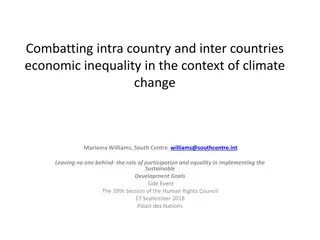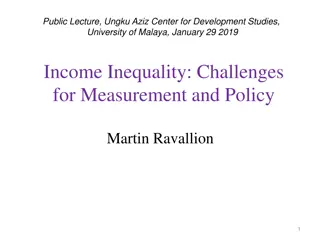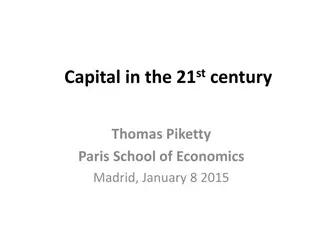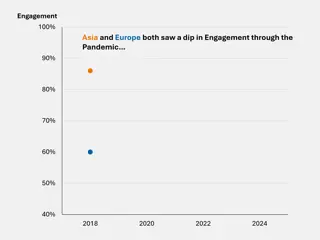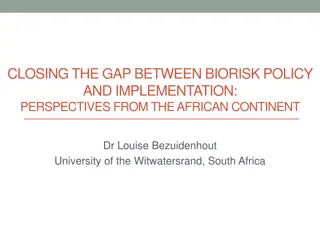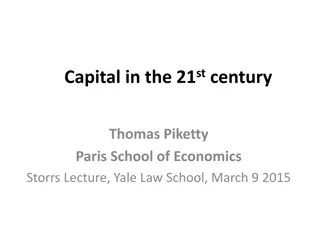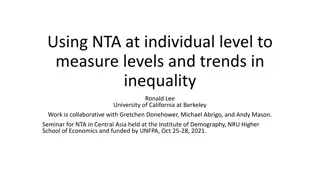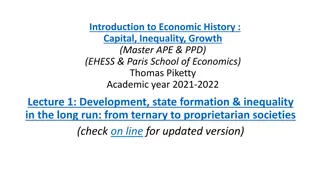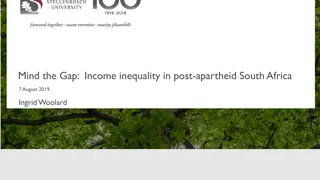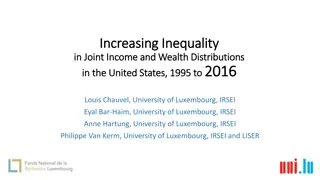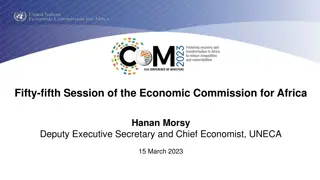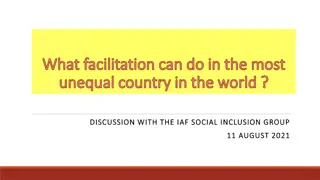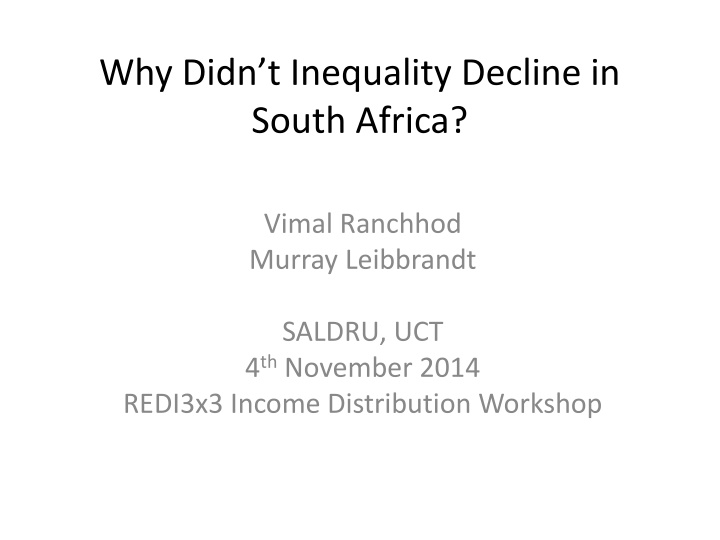
Inequality Trends in South Africa: Causes and Findings
High inequality in South Africa post-apartheid era has remained persistent, with levels likely increasing over the past two decades. Despite slow economic growth and stable fiscal conditions, poverty rates are still high. Various research studies have analyzed the factors contributing to this inequality, highlighting the need for further investigation and policy interventions to address this complex issue.
Download Presentation

Please find below an Image/Link to download the presentation.
The content on the website is provided AS IS for your information and personal use only. It may not be sold, licensed, or shared on other websites without obtaining consent from the author. If you encounter any issues during the download, it is possible that the publisher has removed the file from their server.
You are allowed to download the files provided on this website for personal or commercial use, subject to the condition that they are used lawfully. All files are the property of their respective owners.
The content on the website is provided AS IS for your information and personal use only. It may not be sold, licensed, or shared on other websites without obtaining consent from the author.
E N D
Presentation Transcript
Why Didnt Inequality Decline in South Africa? Vimal Ranchhod Murray Leibbrandt SALDRU, UCT 4thNovember 2014 REDI3x3 Income Distribution Workshop
Overview Levels and Trends in inequality Causes of inequality Empirical findings Future research Conclusion
Household income share Gini Year Gini Rank top 10% bot. 10% ratio Botswana 0.63 1993 2 - - - South Africa 0.631 2005 3 51.70% 1.20% 43.08 Swaziland 0.504 2001 20 40.10% 1.70% 23.59 US 0.45 2007 41 30% 2% 15.00 UK 0.4 2009 60 28.50% 2.10% 13.57 Germany 0.27 2006 126 24% 3.60% 6.67 Japan 0.376 2008 76 27.50% 1.90% 14.47 Brazil 0.519 2012 17 42.90% 0.80% 53.63 Russia 0.417 2011 52 42.50% 5.70% 7.46 India 0.368 2004 78 31.10% 3.60% 8.64 China 0.474 2012 29 - - - Data source: World Factbook (CIA) URL https://www.cia.gov/library/publications/the-world-factbook/ Accessed on 1st September 2013
Background (1) High inequality in SA is a long run phenomenon. Post-apartheid levels are consistently high, and have probably increased over the past twenty years. Several researchers; Leibbrandt et al (2001), Hoogeveen and Ozler (2005), Leibbrandt, Levinsohn and McCrary (2010), Leibbrandt, Woolard, Finn and Argent (2010), van der Berg and Louw (2004), van der Berg, Louw and Yu (2008) and Yu (2010)...(and others) Various estimates of inequality, but a useful range for Gini coefficient would be about 0.65 0.70
Background (2) SA post 1994 has slow but relatively stable growth rates. Poverty rates remain high ( about 50%) Small but growing middle class General depreciation of currency in nominal terms Mostly stable fiscal situation, reduction of national debt, inflation generally in targeted bandwidth (or close thereto)
Generalized Lorenz Curves 1993, 2000, 2010
Gini Coefficients 1993 and 2010 Gini 1993 2010 Overall 0.674 0.696 Deciles 1-9 0.524 0.525 Deciles 1-8 0.450 0.438 Decile 10 0.327 0.351 Deciles 1-4 With grants 0.338 0.297 W/Ogrants 0.491 0.604
Sources of Income Inequality Differences in productive endowments (Health, skills etc at birth) Differences in the development of productive endowments/skills, eg. Schooling, transfer of skills from parents Differences in effort The way a society is structured Laws, property rights, access to markets Bargaining power Group level discrimination (Gender, race)
The evolution of Inequality Kuznets theory: Skilled biased technological change Inequality Traps Piketty s Capital in the 21stCentury Economic Political Social
Inequality Traps Economic inequality traps Rich and poor face different costs of investments Rich will invest while poor will not be able to Rich will get high returns while poor will not Leads to persistence of inequality Example in SA would be good quality schools Political inequality traps Rent seeking and lobbying can distort the way markets operate in favour of the wealthy and the politically connected (Could be the same people) Poor remain poor, rich remain rich
Inequality Traps Social Inequality traps Neighbourhood stratification makes wealthier areas more productive. Think of schools, infrastructure, safety, libraries, role models, peer effects, gangs Rich remain rich and poor remain poor In the inequality traps literature, the high inequality state is not efficient
Sources of trends in inequality in SA Labour market both unemployment and wage distribution Cash transfers (part of more general issue of taxes and expenditures) Education Attainment Returns to education
Sources of Income Inequality in SA Tax systems (progressive or regressive) Transfers from the state Grants Public goods Differences in wealth Differences in inheritances
Summary (1) Inequality in South Africa and Brazil: Can We Trust the Numbers? . (Finn and Leibbrandt) Methodological paper assessing whether inequality measures from these countries can be compared. Finds that inequality is unambiguously higher in South Africa. The Distribution of Wealth in the National Income Dynamics Study Wave 2 . (Daniels, Finn and Musundwa) Analyse the distribution of assets and liabilities and compares the inequality of wealth to the inequality of income in the country using wave 2 of NIDS data. Wealth inequality is much (MUCH) higher than income inequality.
Summary (2) Post-apartheid Changes in South African Inequality (Finn, Leibbrandt and Woolard) Explores dimensions/components of income inequality and changes from 1993 (PSLSD) to 2008 (NIDS Wave 1). Labour market was and remains key to understanding inequality. Trends in South African Income Distribution and Poverty Since the Fall of Apartheid . (Finn, Leibbrandt and Woolard) Income inequality has increased on aggregate and within races. (1993 2000 2008). Race based redistribution unlikely to be sufficient to decrease inequality. Social grants became more important, affect poverty but small effect on inequality. Substantial improvements in non-monetary well-being (access to electricity, housing, water etc.)
Income Mobility Evidence from three waves of NIDS
Average returns to schooling in schooling groups, South Africa 1994-2011 Matrix plus Inc. Sec. Primary .4 .35 Average return per year .3 .25 Declines in returns to Inc. Sec. in 2000s these are now disequalizing. .2 .15 .1 .05 0 1994 1995 1996 1997 1998 1999 2000 2001 2002 Year 2003 2004 2005 2006 2007 2008 2009 2010 2011 Weighted average of marginal returns to each year of schooling in schooling range
Increases in returns to schooling at grade 10 would have been disequalizing in 1994, but they would be equalizing in 2011. Increases in returns to grade 15 are more disequalizing in 2011 than they were in 1994
Performance on aptitude test by income group: Ages 14 - 16 Source: CAPS Wave 1 (2002) .8 .6 .4 .2 0 -2 -1 0 1 2 Standardized LNE total score Low income Upper income Middle Income
Performance on aptitude test by income group: Ages 17 - 19 Source: CAPS Wave 1 (2002) .8 .6 .4 .2 0 -3 -2 -1 0 1 2 Standardized LNE total score Low income Upper income Middle Income
Performance on aptitude test by income group: Ages 20 - 22 Source: CAPS Wave 1 (2002) .8 .6 .4 .2 0 -3 -2 -1 0 1 2 Standardized LNE total score Low income Upper income Middle Income
Table 2: Mean of some tertiary qualification in NIDS (by age and income quintile) Per capita household income quintiles age 1 2 3 4 5 Total 18 0.000 0.000 0.007 0.000 0.000 0.001 19 0.000 0.041 0.004 0.005 0.037 0.016 20 0.050 0.036 0.038 0.054 0.212 0.070 21 0.035 0.106 0.034 0.043 0.290 0.087 22 0.035 0.063 0.026 0.117 0.345 0.101 23 0.005 0.089 0.007 0.130 0.233 0.084 24 0.097 0.123 0.098 0.157 0.314 0.151 Total 0.027 0.058 0.031 0.075 0.191 0.068
Future research Effect of demography on inequality Credit markets, access and costs Why so little entrepreneurship? Costs of banking Top incomes Labour market: Unemployment, wage dispersion, regulations, discrimination Pre-labour market differentials, including social and psychological components
Conclusion We live in the most unequal region of the world Our inequality is chronically high and stable This is both unjust (depending on how one defines justice) and probably inefficient We could probably do better, i.e. Lower inequality and simultaneously enhance our economic performance There are many different ways to approach this complex problem, although unlikely to have a single solution. With time, we can unravel components of this process and move towards better and more informed understanding and policy.


